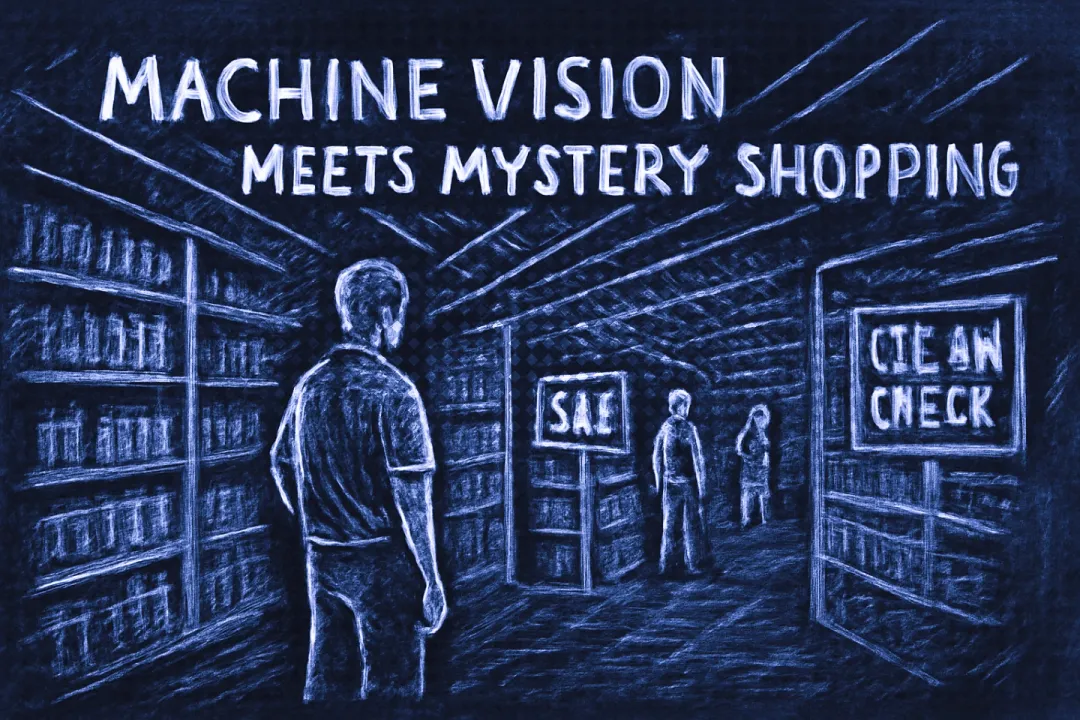
Machine Vision Meets Mystery Shopping: AI Eyes on Your Store
Learn how computer vision AI acts as a digital mystery shopper, using cameras to monitor store displays, cleanliness and compliance in real-time.
Machine Vision Meets Mystery Shopping: AI Eyes on Your Store
Imagine having an extra set of eyes in your stores, diligently checking if displays are perfect, shelves are stocked, and service areas are clean – 24/7. This isn’t science fiction; it’s becoming a reality with Computer Vision, a fascinating field of Artificial Intelligence (AI). When applied to mystery shopping and retail audits, computer vision acts like a digital mystery shopper, using cameras and smart algorithms to observe and analyze the physical environment.
Let’s explore how this technology works and how it can provide your team with objective, visual data to complement traditional mystery shopping methods. For a broader understanding of AI’s role in audits, you might want to read AI in Mystery Shopping: What It Is & How It Works.
What is Computer Vision in Retail Audits?
At its core, Computer Vision enables computers to ‘see’ and interpret information from images or videos, much like humans do. In a retail or hospitality setting, this means AI algorithms can analyze footage from store cameras (fixed or even mobile, like those on robotic assistants) or photos taken by human auditors or staff.
The AI is trained to recognize specific objects, patterns, and conditions. For example, it can learn what a fully stocked shelf of a particular product looks like, identify a specific promotional display, or detect if a floor area is clean or cluttered.
This technology doesn’t aim to replace human observation entirely but rather to augment it, providing a consistent and often more scalable way to monitor physical brand standards and operational compliance. We discuss the collaborative aspect in AI vs Human Mystery Shoppers: Finding the Right Balance.
Applications of Computer Vision in Mystery Shopping & Audits
The potential uses for your business are extensive, especially in environments where visual presentation and physical conditions are key to the customer experience:
Shelf Presence & Stock Levels
- Out-of-Stock (OOS) Detection: AI can scan shelves and identify empty spaces where products should be, alerting your team to potential lost sales. This can be far more efficient than relying solely on manual checks.
- Product Placement & Facing: Ensure products are in the correct location and presented attractively (e.g., labels facing forward).
Merchandising and Display Compliance
- Planogram Adherence: AI can compare an image of a display with the intended planogram (the diagram showing how products should be arranged) and flag discrepancies.
- Promotional Display Audits: Verify that temporary promotions, signage, and special offers are set up correctly and in the right locations.
- Pricing Accuracy: Some advanced systems can even cross-reference product images with pricing information to check for consistency.
Queue and Service Time Monitoring
- Wait Time Measurement: Vision systems can analyze video feeds from checkout areas or service counters to measure queue lengths and average wait times, providing objective data on service speed.
- Staff Presence: AI can verify if service points are adequately staffed during peak hours.
Cleanliness and Safety Checks
- Identifying Cleanliness Issues: AI can be trained to spot spills, litter, dirty tables (in a restaurant setting), or untidy areas that detract from the customer experience.
- Detecting Hazards: Flag potential safety issues like blocked fire exits or items obstructing walkways.
Example Scenario: AI Camera Audit vs. Human Shopper
Consider a busy supermarket aisle:
- AI Camera System: Continuously monitors a specific high-traffic aisle. It flags an out-of-stock on a popular cereal brand within minutes of it occurring. Later, it notes that a promotional display for a new soda is correctly placed according to the planogram but is missing a price tag.
- Human Mystery Shopper: Visits the store once that day. They might notice the out-of-stock cereal if it’s still an issue during their visit. They might also spot the missing price tag. However, they also observe the helpfulness of a staff member in that aisle and the general ambiance – qualitative aspects the AI camera doesn’t capture.
This illustrates how computer vision provides consistent, objective data on specific visual criteria, while human shoppers add crucial qualitative context and assess service interactions.
Benefits of Using Computer Vision
Integrating AI-powered visual audits can offer your team significant advantages:
- Continuous Monitoring: Unlike periodic human visits, AI can (if using fixed cameras) monitor conditions around the clock, providing a more dynamic view of store operations. This also ties into the idea of AI’s “unlimited scale” in monitoring digital touchpoints or in-store IoT data.
- Objective Data: Visual evidence (images or video clips) backs up the AI’s assessments, reducing subjectivity and potential disputes.
- Increased Coverage & Scale: Audit more locations or more areas within a location more frequently than would be feasible with human auditors alone.
- Efficiency Gains: Automate routine visual checks, freeing up human auditors and store staff to focus on more complex tasks or customer interactions.
- Faster Issue Identification: Get quicker alerts on problems like out-of-stocks or compliance failures, enabling faster corrective action.
Challenges to Overcome
While powerful, implementing computer vision also comes with considerations:
- Setup Costs and Infrastructure: May require investment in cameras (if not using existing ones), software, and potentially on-site processing or cloud services.
- Accuracy and Training: AI models need to be well-trained with high-quality, diverse image data to perform accurately. Factors like lighting, camera angles, and visual clutter can affect performance.
- Privacy Considerations: Using cameras to monitor store environments requires careful attention to customer and employee privacy. Clear policies, signage, and adherence to data protection laws are essential. We delve into this in Ethical AI in Mystery Shopping: Guidelines for Fair and Effective Use and Privacy and Data Security in AI Mystery Shopping.
- Integration with Other Systems: The visual data needs to be integrated into your overall audit reporting and action management workflows.
Combining Vision Data with Traditional Mystery Shopping
The most effective approach often involves blending AI-driven visual audits with traditional mystery shopping:
- Unified Dashboards: Imagine reports where a human shopper’s feedback on service is presented alongside AI-generated data on shelf availability for that same store visit.
- Targeted Human Audits: Use computer vision insights to direct human shoppers to areas needing more in-depth qualitative assessment.
- Training with Visuals: Use the images and videos captured by AI to provide clear, visual examples to staff during training on brand standards or operational procedures. This can be very impactful, as discussed in From Data to Action: Using AI Mystery Shop Insights to Train Your Team.
Conclusion: AI Eyes for Sharper Insights
Computer vision is rapidly becoming a valuable tool in the mystery shopping and retail audit toolkit. By providing tireless, objective, and scalable data on physical store conditions, it enhances the thoroughness of audits and helps maintain high standards in real time. When integrated thoughtfully with human insights, it empowers businesses to identify issues faster, make data-driven improvements, and ultimately, deliver a consistently excellent customer experience.
